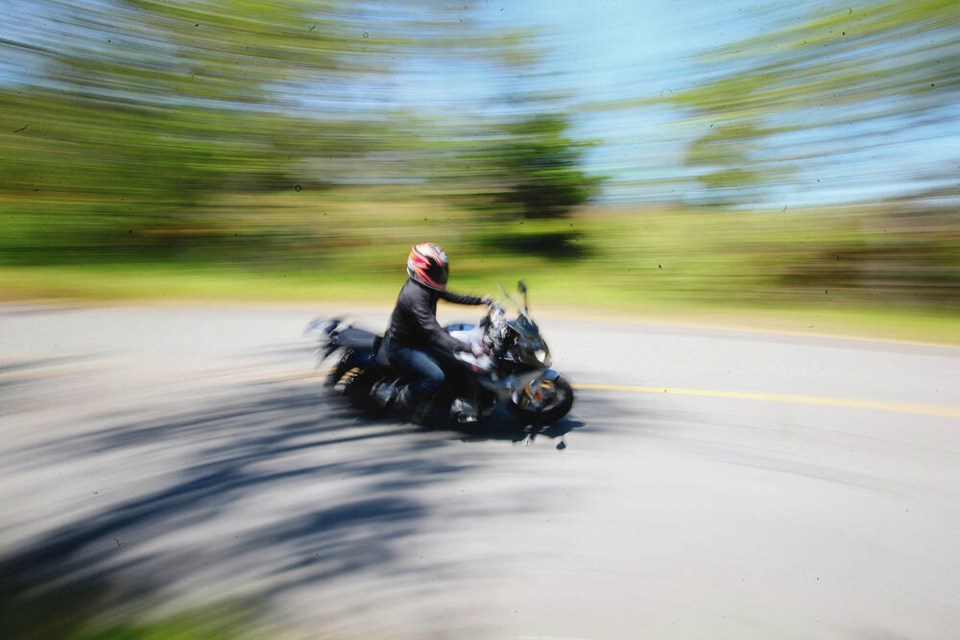With all the recent headlines focused on forest fires, submarine catastrophes and battles in Ukraine, you might have missed that there is an ongoing, disturbing trend around motorcycle fatalities plaguing BC roads since the early spring.
From Nanaimo to Penticton, there’s been a steady stream of reports of motorcycle deaths this year. Vancouver Island has witnessed three serious crashes so far and at least four riders have been killed in Surrey alone.
What’s going on? We will have to wait for the coroner’s reports for definitive answers but some other experts are already seeing three basic problems.
There is a post pandemic rush for people to travel and many are taking up motorcycling as their outlet — putting more bikes on our roads.
Those increased numbers include new riders who aren’t sufficiently trained nor experienced to handle the demands of our increasingly crowded roads.
Finally, failures in road design and road maintenance are creating more dangers for motorcycle riders. More on this in another column.
I rode for years and know that riding is one of the greatest pleasures you can experience in life. But as a rider, from day one, you have to be realistic about what you’re getting into.
You have to have a much higher skill set to ride as compared with driving. The necessity to manoeuvre and react is much higher than when driving a car. That’s because motorcycles are harder for other motorists to see, increasing the risk of crashes.
Things such as road hazards, rogue cars, slippery roads, fatigue, lack of sleep, sunlight and glare are all factors which double or triple the risk for riders.
Colliding with other vehicles, speeding, drinking alcohol, not wearing a helmet, and getting older are the other top contributing factors in fatal motorcycle fatalities.
In the United States, the fatality rate per registered vehicle for motorcyclists is six to seven times higher than the fatality rate for passenger car occupants.
Motorcyclists are around 25 times more likely than passenger car occupants to die in a crash per vehicle kilometre travelled and nearly five times as likely to be injured.
I wrote previously that in Canada, for example, motorcycles accounted for 14% of all crash-related fatalities, even though they were only 3% of the vehicles on the road according to the RCMP Highway Patrol.
For riders, you must do everything possible to reduce your risk.
This includes wearing a helmet and protective gear.
Helmets can reduce the risk of head injury by 69% and death by 42%. Protective gear such as gloves, jackets, pants, boots, and eye protection can also prevent or minimize injuries from abrasion, impact or weather.
Proper training and practice is essential. Training by reputable instructors ensures riders develop the skills and confidence to handle different situations on the road. And like any activity, practice can help riders maintain their skills and improve their reaction time.
Don’t ride drunk or high. What are the basics of riding safely? Judgement, co-ordination, balance, vision, and reaction time — the very things that booze and drugs take away from you. They also increase fatigue and aggression, not to mention that whole illegal part.
Don’t speed or weave through traffic. Lane splitting is illegal and speeding between cars reduces the time and distance available to react to hazards or avoid collisions. It also increases the severity of injuries in a crash. Weaving through traffic often startles and angers other drivers creating dangerous situations.
Visibility and alertness are also key. Reflective vests, headlights, signaling, and your horn are all important to make yourself seen by other drivers.
Remember, blind spots are deadly, so always position yourself strategically on the road. Regular practice helps you develop that sixth sense around anticipating potential hazards and other drivers’ actions.
At minimum, you’ll reduce risk by simply keeping a safe distance from other vehicles and adjusting your speed to road and traffic conditions.
Glove Box: Speaking of speeding. Here’s the worst of the worst. In 2003, a driver in Texas was nabbed at 389 km/h by a state trooper using a laser gun. He was driving a modified Ford GT40 on a toll road. He was charged with reckless driving and fined $300.
There is a three-way tie for second:
France 2007 — A Mercedes CLS 63 AMG nailed by a police helicopter for 308 km/h. The driver was arrested and the car impounded.
Ontario 2014 — A Kawasaki Ninja motorcycle, doing 308 km/h was caught on radar by OPP on Hwy 407. Driver was charged with stunt driving and the car impounded.
Nottinghamshire, U.K., 2021 — An Audi RS6 was nabbed at 308 km/h on the M1 motorway via police radar. The driver was arrested and the car seized.
>>> To comment on this article, write a letter to the editor: [email protected]



